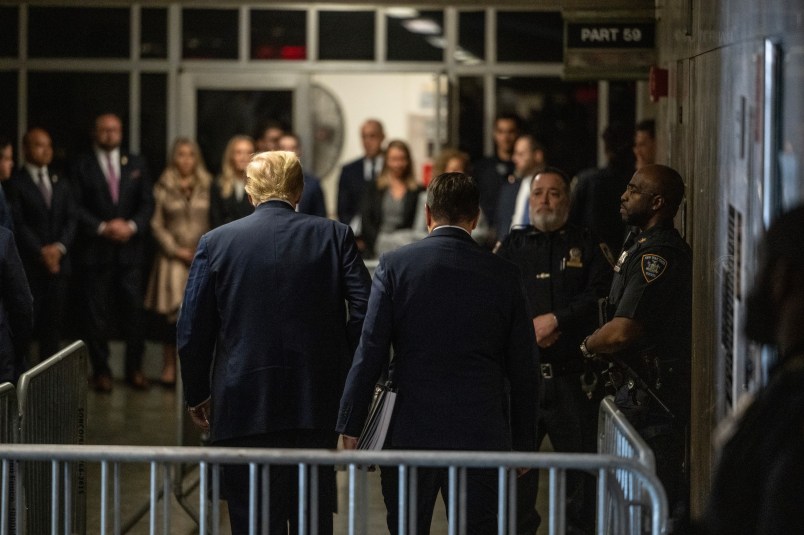I’m reviewing a book on the president’s foreign policy. And there’s a reference late in the book to a May 3rd article in the New York Times.  If you want to get a sense of just how unprepared this administration was for what they were getting themselves into, you can’t do much better than rereading this piece.
If you want to get a sense of just how unprepared this administration was for what they were getting themselves into, you can’t do much better than rereading this piece.
(Unfortunately, the Times no longer posts their archives.)
The plan at that time was to quickly draw down the American troop presence in Iraq until they numbered about 30,000 by the fall of 2003. Needless to say, the fall of 2003 is pretty much now.
Just think how wide of the mark these guys were.
Not that any of this was a surprise, of course. Just before the outbreak of war, then-Army Chief of Staff Eric Shinseki told a Senate committee that he thought “something on the order of several hundred thousand soldiers” would be necessary to pacify and stabilize post-war Iraq.
He had some experience. He’d led the peace-keeping operation in Bosnia. And he’d dedicated much of his tenure as Chief of Staff to preparing the Army for peace-keeping and other non-traditional and low-intensity combat deployments.
A few days later Paul Wolfowitz went up to the Hill and said Shinseki had no idea what he was talking about. His estimate was “wildly off the mark,” Wolfowitz said.
Obviously it was Wolfowitz who had no clue what he was talking about.
And now we have this: according to a new Congressional Budget Office study, the US will only be capable of maintaining our current troop strength in Iraq till next March. By this time next year, says an AP story about the study, “the 180,000 American troops now in and around Iraq would have to be drawn down to [between] 38,000 to 64,000.”
Let’s walk through what this means.
Virtually every independent observer believes our forces in Iraq are stretched too thin. The issue isn’t only numbers. But it’s a key, probably the key part of the puzzle. People who work at the pleasure of Don Rumsfeld say differently. And so do a few  mumbo-jumbocrats on the right. But no one else.
mumbo-jumbocrats on the right. But no one else.
Large areas of Iraq remain quiet and peaceable. But key sections of the country appear to be teetering either on the edge of chaos or a sort of endemic violence that will be hard to pacify. And those sections are arguably some of the more pivotal in the country — Baghdad, Najaf, etc.
We may be moving toward a situation in which intra-ethnic and intra-religious rivalries break out into open, if low-level, violence — a sort of slow-motion civil war.
I doubt we’re close to that yet. But even seeing it on the horizon is ominous. Because were that to happen our difficulties would grow almost immeasurably.
Absent a substantial increase in the size of the Army, or lengthy deployments and reserve call-ups which most experts consider unsustainable, we clearly need others to come in and lend a hand. Now we find out that we can only sustain current levels for roughly six months. How much leverage do you figure that gives us with the countries we’d like to have send in their own troops? How much leverage does that give us with France, Russia and China?
Right. Not much.
News tonight says that we’re about to make a big push for greater UN involvement — perhaps circulating a new resolution as early as tomorrow. Unfortunately, this request comes not at a moment of strength for us but in the face of four car-bombings in a month and a palpable sense that we are not in control of the country we are nominally occupying. Add that to the fact that we’re already stretched thin and, according to our own government study, can’t maintain the current force for much more than six months. Again, put that all together and then ask, how much leverage do we have?
In real life we have a word for this sort of situation: a jam. We’ve managed to leverage our mammoth strength into an improbable weakness. And so much of it was not only predictable, but predicted.
Consider an analogy. When a heart surgeon loses an occasional patient, that’s simply the price of inherently dangerous work. When a heart surgeon tries a risky procedure for a patient who will die without it, and the patient dies, that’s just a tragic end to an unavoidable risk. When a dermatologist cracks open a patient’s ribs to try out a new approach to open heart surgery which most cardiac surgeons say will never work, and the patient dies, that guy probably gets sued or kicked out of the profession or maybe thrown in jail. Maybe all three.
True enough, the patient hasn’t died. As Fareed Zakaria says in this superb piece in Newsweek, “It might already be too late to achieve a great success in Iraq. But it is not too late to avoid a humiliating failure.”
All true enough. But the real question is, who gets fired over this mess? And when?







